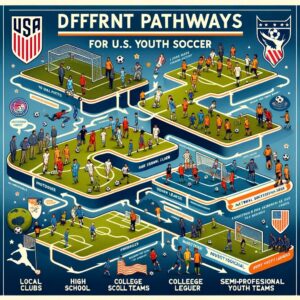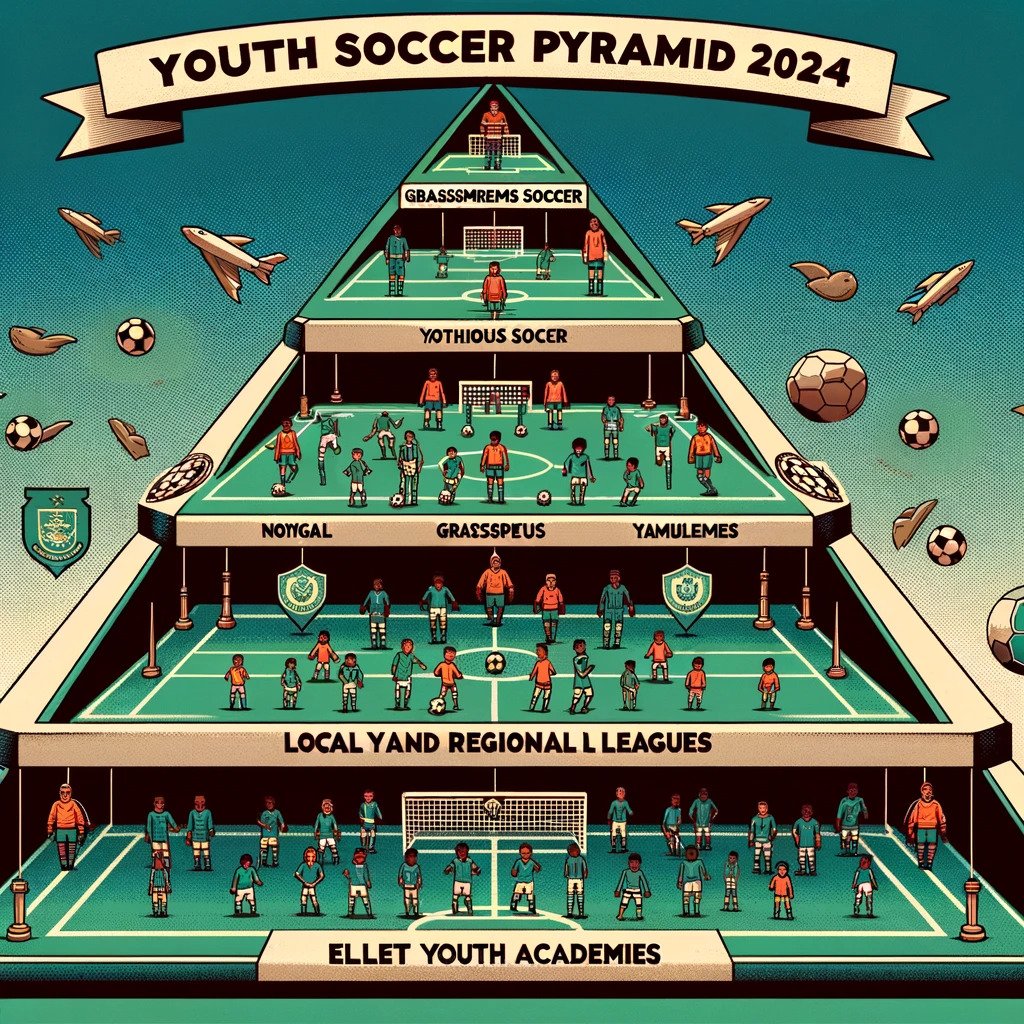In the last few decades, the landscape of youth soccer in the U.S. has evolved significantly. Once dominated by town-based teams and travel leagues, now the scene is bustling with soccer clubs designed to cater to athletes aiming to play more competitively. This transformation, while exciting, can be quite confusing for parents and players navigating the myriad of options.
At the youth level, the pyramid is structured by key organizations such as USYS, USSSA, and US Club Soccer. Each of these entities endorse and maintain various leagues, offering a diverse range of playing experiences. As someone who has been closely involved in youth soccer, I understand the importance of finding the right path for your player. It’s crucial to recognize that their journey in soccer is fluid, changing at different stages of their development.
In my experience, the key is to stay adaptable and open to change. The right fit at one stage of a player’s development might not be the same at another. So, keeping an open mind and being willing to adjust the course is essential in nurturing a young athlete’s growth in soccer. Anyways, let get more into Youth soccer pyramid 2024.
The U.S. Youth Soccer Pyramid
In the dynamic world of youth soccer, the U.S. structure resembles a well-organized pyramid, each level crafted to cater to different stages of a player’s development.
Presenting the structure of youth soccer in the U.S. as a pyramid truly captures its hierarchical and progressive nature. From foundational levels to elite platforms, each tier represents a step forward in the development and competitiveness of young players.
- Town Recreational Leagues: The base of the pyramid, where the youngest athletes get their first taste of soccer, emphasizing fun and basic skill development.
- Town Travel Leagues: The next step up, introducing a more competitive environment, while still focusing on learning and enjoyment.
- Youth Academy: This tier is for players showing promise and dedication, offering advanced training to refine skills and tactics.
- National League Conferences (NPL and ECNL Regional Leagues): Regional leagues providing higher levels of competition and exposure, pivotal for players looking to get noticed.
- The National League (ENPL and ECNL): The apex of regional play, where the most skilled youth players compete at a national level.
- Development Player League (DPL): A specialized league focused on individual player development, often seen as a stepping stone to higher levels.
- Girls Academy (GA) and MLS Next: These leagues provide tailored environments for girls and boys, respectively, ensuring gender-specific development opportunities.
This structured approach not only guides players through their soccer journey but also ensures they are in the right environment for their skill level and aspirations.
Organizations of Youth Soccer in the U.S.
As soccer has evolved over the years, several key organizations have emerged to sanction and shape its landscape in the United States. These entities play a vital role in the development and expansion of youth soccer, each contributing uniquely to the sport’s growth.
The United States Sports Specialty Association (USSSA), a non-profit organization, has been affiliated with U.S. Soccer since 2001. Its primary mission is to develop and expand the game of soccer across the nation. The USSSA is known for its sanctions on leagues like the Development Player League (DPL) and the Elite Academy League (EA), both of which have become integral parts of the youth soccer pyramid.
Another pillar in this structure is U.S. Youth Soccer (USYS), renowned as the nation’s largest youth sports organization. USYS registers nearly 3 million soccer players and over 10,000 clubs annually, showcasing its immense impact on the sport. USYS provides a framework for multiple levels of play, catering to both boys and girls. Their notable contributions include the MLS Next program, developed in partnership with MLS, as well as the GA and National League Conferences, which offer competitive platforms for young athletes.
Lastly, U.S. Club Soccer stands as a significant national organization and a proud member of the U.S. Soccer Federation. Its focus is to develop and support soccer clubs throughout the U.S. They endorse various competitive leagues such as ECNL, ECNL Regional Leagues, NPL, and ENPL, providing a broad range of opportunities for youth players to excel.
Each of these organizations contributes uniquely to the dynamic ecosystem of youth soccer in the U.S., offering various pathways for young athletes to develop their skills and compete at different levels.
Different Pathways for U.S. Youth Soccer

The landscape of youth soccer in the United States offers a variety of paths, each tailored to nurture and develop young talent.
At the foundational level, we have the Youth Academy, where soccer clubs in your region introduce kids, especially those in the U8 to U10 age group, to a more competitive environment than what town travel leagues offer. This stage is crucial for advanced coaching, transitioning from volunteer coach to salaried coach, and for creating a pool of youth players to identify and foster talent at a younger age.
Moving up the pyramid, the National Premier League (NPL), sanctioned by U.S. Club Soccer, represents a significant step up. In the NPL, clubs must have teams across every age group, and the league is known for its Showcase events and a playoff system that pits the top teams from each member league against each other.
National League Conferences: Premier I and II
National League Conferences, particularly the Premier I, stand as the top conference in the system, organized by region. The Premier II division offers additional competitive opportunities, allowing teams to rise through the ranks.
ECNL and Its Regional Leagues
The ECNL Regional Leagues (ECRL) aim to improve coordination and collaboration between teams of different levels within the same club. These leagues focus on regional play, in contrast to the broader, nationally focused ECNL teams.
ENPL and ECNL
At the higher end of the pyramid, we find the Elite National Premier League (ENPL), which is the highest level under the NPL umbrella. These state-based regional teams compete intensely, showcasing some of the best young talents in the nation.
Similarly, the Elite Clubs National League (ECNL), initially formed for girls but now including a boys program, requires its club members to maintain high standards in terms of facilities and coaching. The ECNL has emerged as one of the most innovative and significant large soccer organizations.
DPL and Girls Academy
The Development Player League (DPL), an all-girls national league, provides an elite competition platform for top youth soccer clubs. It focuses on the motto “To develop the player and empower the person in a purposeful and memorable environment.” Meanwhile, the Girls Academy (GA), sanctioned by USYS, aims to prepare female players for college soccer and potentially the women’s National Team.
MLS NEXT
Finally, MLS NEXT, formerly known as the Development Academy (DA), represents the highest level for boys soccer teams, starting from U13. Affiliated with Major League Soccer (MLS), it serves as a direct pathway to professional teams.
US Youth Soccer Programs
US Youth Soccer offers an impressive array of programs that cater to various aspects of youth soccer development. From my experience, these programs play a crucial role in nurturing young talents. A few of the prominent programs include:
- National Championship Series: This program showcases the best in competitive youth soccer, where teams vie for top honors, emphasizing skill, teamwork, and sportsmanship.
- Olympic Development Program: A unique platform focusing on individual player development, this program offers exposure to higher-level coaching and play, ideal for those with aspirations beyond club soccer.
- TOPSoccer: A heartwarming initiative, TOPSoccer opens the beautiful game to young athletes with disabilities, embodying the spirit of inclusivity and community in sports.
- Esports Initiative: Reflecting modern trends, the Esports initiative engages youth in the digital realm, offering a fresh perspective on sportsmanship and competition in the virtual world.
What is the Best Pathway for a Youth Soccer Player?
For a serious and committed soccer player, choosing the right club and league can be a challenging task, especially at younger ages. It’s essential to explore various options and determine the best path for your child. Each choice comes with its pros and cons, and the decision is not just about the level of play but also about the player’s aspirations and the family’s capacity to support their journey.
The MLS Next pathway, for example, offers the chance to be coached and compete at the highest level. However, it involves extensive travel, with players often required to fly across the country for a game or to attend a Showcase in the fall or spring season. While this can be an exciting opportunity, it’s important to consistently gauge your child’s interest in competitive soccer and ensure they do not lose their passion in the process.
Choosing to remain in town travel leagues can be more suitable for those who enjoy the sport but may not thrive in high-pressure situations. Every player is different, and understanding your child’s player’s needs, desires, and personal situation is crucial. Club soccer in the U.S. can be expensive, and the time commitment can be taxing on some families.
Ultimately, it’s about finding a balance. Remember, while some kids might aspire to turn pro or play in college, the primary goal should always be to give them the opportunity to have fun and enjoy the game of soccer. Carefully weigh all the options before committing to a soccer club.
What is the difference between NPL and DPL?
In the 2024 youth soccer pyramid, the NPL (National Premier League) primarily caters to boys’ teams, competing in leagues like the South Atlantic Premier League under the guidance of Ralph Latchana. Meanwhile, the DPL (Development Player League) focuses on girls’ teams, with squads participating in divisions such as the Southeast Division, directed by Sheldon Russell. This distinction highlights the tailored approach of each league in nurturing young talents in their respective categories.
Conclusion
As we look towards the future of youth soccer, the “Youth Soccer Pyramid 2024” shows a dynamic and well-structured approach to nurturing young talents. With a range of leagues and programs tailored for different age groups, skill levels, and genders, the pyramid ensures that each player can find a path that aligns with their ambitions and abilities. From local town leagues to national competitions, this structure not only fosters skill development but also instills a love for the game, ensuring a bright future for soccer in the United States.
Frequently Asked Questions
Is EDP a good league?
EDP (Eastern Development Program) is considered a reputable league, offering competitive play and development opportunities, especially in the Eastern United States. It’s a part of the youth soccer pyramid aimed at player growth.
Is ECNL better than MLS NEXT for boys?
ECNL (Elite Clubs National League) offers high competition and exposure, while MLS NEXT, linked with Major League Soccer, provides a direct pathway to professional soccer. Each has its unique strengths.
Is GA higher than DPL?
GA (Girls Academy) is often seen as a higher tier compared to DPL (Development Player League) due to its competitive level and exposure opportunities, focusing on the development of female soccer players at a national scale.
Is ECNL better than girl’s academy?
Both ECNL and Girls Academy offer high-level competition; the choice depends on specific needs and goals. ECNL is known for its nationwide competitions and exposure, while Girls Academy focuses on elite player development.
What does DPL mean in soccer?
DPL stands for Development Player League, a league within the youth soccer pyramid focusing on the advancement and competitive play of youth soccer players, particularly girls.
What is VIP in soccer?
VIP in soccer usually refers to a “Very Important Player” program or concept, often focusing on providing special attention or resources to standout players within a league or club.

